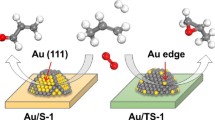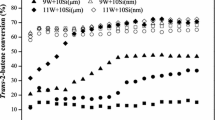Abstract
In this paper, a DFT calculation was used to demonstrate the catalytic role of a WOX/SiO2 catalyst and show the excellent performance in 2,5-dimethylfuran to para-xylene conversion. A model of highly dispersed tungsten oxide supported on the amorphous silica was firstly constructed. A periodic DFT calculation was thereafter carried out to determine the reaction pathway, transition state (TS) and important intermediate structures. For reference purpose, the calculation was also repeat on an alkali ion, representative of a Lewis acid catalyst. Unexpectedly and although tungsten oxide is generally considered and characterized to be a Lewis acid, its mechanism for catalyzing the conversion of 2,5-dimethylfuran and ethylene to PX is differs significantly from other Lewis acids like alkali metal. Typical epoxide intermediates observed in other Lewis acid catalyzed systems are not formed over a WOX/SiO2 catalyst. The calculated reaction barrier indicated that the WOX/SiO2 catalyst has no obvious catalytic effect on the Diels–Alder cycloaddition for 2,5-dimethylfuran and ethylene. It mainly accelerates the dehydration step. The reason for the unique catalytic mechanism of WOX/SiO2 catalyst relies on the coordination of 2,5-dimethylfuran and tungsten that leads to the Diels–Alder cycloaddition that follow the so-called inverse electron demand mechanism. A new catalyst for this reaction was proposed based on the obtained mechanistic understanding.
Graphic Abstract







Similar content being viewed by others
References
Mettler MS, Vlachos DG, Dauenhauer PJ (2012) Energy Environ Sci 5:7797–7809
Pang J, Zheng M, Sun R, Wang A, Wang X, Zhang T (2016) Green Chem 18:342–359
Huber GW, Iborra S, Corma A (2006) Chem Rev 106:4044–4098
Bruijnincx PC, Weckhuysen BM (2013) Angew Chem Int Ed Engl 52:11980–11987
Carlson TR, Cheng Y-T, Jae J, Huber GW (2011) Energy Environ Sci 4:145–161
Lyons TW, Guironnet D, Findlater M, Brookhart M (2012) J Am Chem Soc 134:15708–15711
Cheng YT, Jae J, Shi J, Fan W, Huber GW (2012) Angew Chem Int Ed Engl 51:1387–1390
Lin Z, Ierapetritou M, Nikolakis V (2013) AIChE J 59:2079–2087
Grieco PA, Nunes JJ, Gaul MD (1990) Cheminform 21:4595–4596
Casaschi A, Desimoni G, Faita G, Invernizzi AG, Lanati S, Righetti PP (1993) J Am Chem Soc 115:8002–8007
Nikbin N, Do PT, Caratzoulas S, Lobo RF, Vlachos DG (2013) J Catal 297:35–43
Li Y-P, Head-Gordon M, Bell AT (2014) J Phys Chem C 118:22090–22095
Nikbin N, Feng S, Caratzoulas S, Vlachos DG (2014) J Phys Chem C 118:24415–24424
Cho HJ, Ren L, Vattipalli V, Yeh Y-H, Gould N, Xu B, Gorte RJ, Lobo R, Dauenhauer PJ, Tsapatsis M, Fan W (2017) ChemCatChem 9:398–402
Liu Y, Li Q, Gao S, Shang JK (2014) CrystEngComm 16:7493–7501
Peng Y, Li J, Chen L, Chen J, Han J, Zhang H, Han W (2012) Environ Sci Technol 46:2864–2869
Feng X, Shen C, Ji K, Yin J, Tan T (2017) Catal Sci Technol 7:5540–5549
Pitman MC, van Duin AC (2012) J Am Chem Soc 134:3042–3053
Fogarty JC, Aktulga HM, Grama AY, van Duin ACT, Pandit SA (2010) J Chem Phys 132:174704
Lwin S, Wachs IE (2014) ACS Catal 4:2505–2520
Amakawa K, Sun L, Guo C, Hävecker M, Kube P, Wachs IE, Lwin S, Frenkel AI, Patlolla A, Hermann K (2013) Angew Chem Int Ed 52:13553–13557
Kresse G, Hafner J (1993) Phys Rev B 47:558–561
Kresse G, Furthmüller J (1996) Comput Mater Sci 6:15–50
Kresse G, Furthmüller J (1996) Phys Rev B 54:11169–11186
Perdew JP, Chevary JA, Vosko SH, Jackson KA, Pederson MR, Singh DJ, Fiolhais C (1992) Phys Rev B 46:6671–6687
Kresse G, Joubert D (1999) Phys Rev B 59:1758–1775
Henkelman G, Uberuaga BP, Jónsson H (2000) J Chem Phys 113:9901–9904
Kresse G, Marsman M, Furthmüller J (2013) URL: http://cms.mpi.univie.ac.at/VASP
Yang X, Dai W, Gao R, Fan K (2007) J Catal 249:278–288
Acknowledgements
This work was supported by National Natural Science Foundation of China (Grant U1663227).
Author information
Authors and Affiliations
Corresponding author
Ethics declarations
Conflict of interest
The authors declare that they have no conflict of interest.
Additional information
Publisher's Note
Springer Nature remains neutral with regard to jurisdictional claims in published maps and institutional affiliations.
Rights and permissions
About this article
Cite this article
Cui, Z., Fang, Y. & Tan, T. Mechanistic Insight of the Catalytic Role of WOX/SiO2 Catalyst in 2,5-Dimethylfuran to Para-xylene Conversion by DFT Calculation. Catal Lett 150, 794–801 (2020). https://doi.org/10.1007/s10562-019-02977-3
Received:
Accepted:
Published:
Issue Date:
DOI: https://doi.org/10.1007/s10562-019-02977-3




